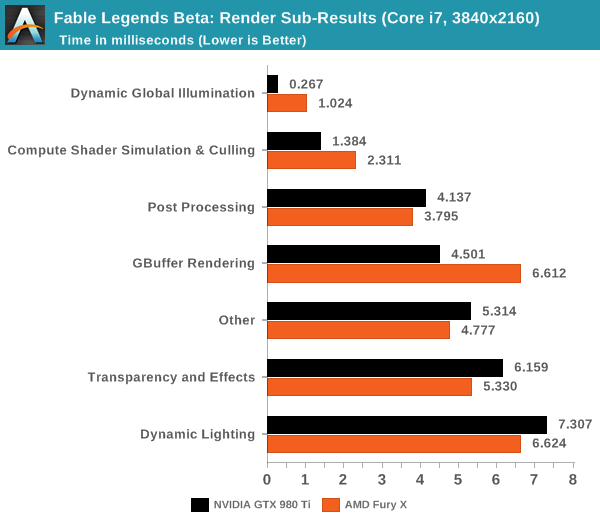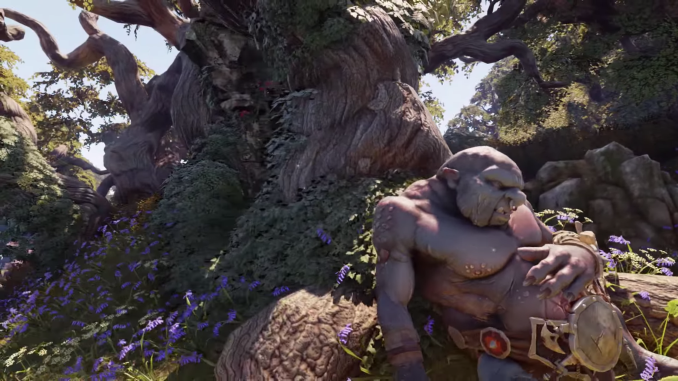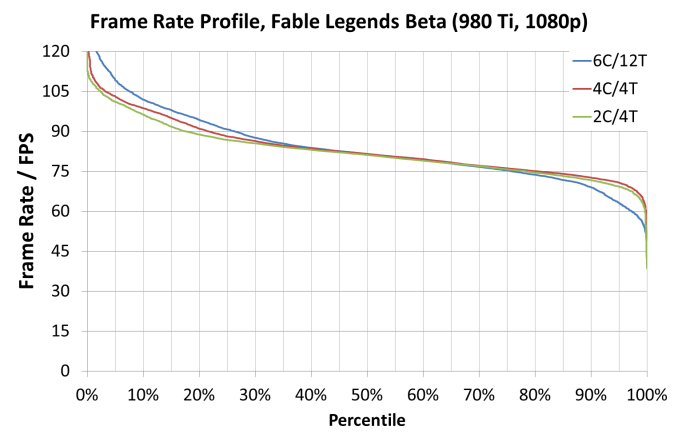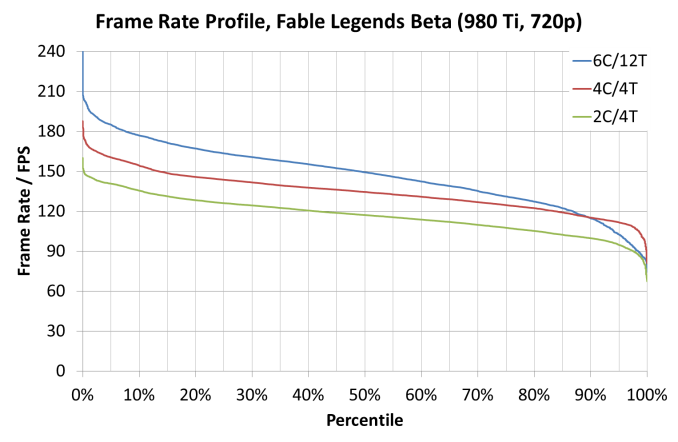Fable Legends Early Preview: DirectX 12 Benchmark Analysis
by Ryan Smith, Ian Cutress & Daniel Williams on September 24, 2015 9:00 AM ESTFinal Words
Non-final benchmarks are a tough element to define. On one hand, they do not show the full range of both performance and graphical enhancements and could be subject to critical rendering paths that cause performance issues. On the other side, they are near-final representations and aspirations of the game developers, with the game engine almost at the point of being comfortable. To say that a preview benchmark is somewhere from 50% to 90% representative of the final product is not much of a bold statement to make in these circumstances, but between those two numbers can be a world of difference.
Fable Legends, developed by Lionhead Studios and published by Microsoft, uses EPIC’s Unreal 4 engine. All the elements of that previous sentence have gravitas in the gaming industry: Fable is a well-known franchise, Lionhead is a successful game developer, Microsoft is Microsoft, and EPIC’s Unreal engines have powered triple-A gaming titles for the best part of two decades. With the right ingredients, therein lies the potential for that melt-in-the-mouth cake as long as the oven is set just right.
Convoluted cake metaphors aside, this article set out to test the new Fable Legends benchmark in DirectX 12. As it stands, the software build we received indicated that the benchmark and game is still in 'early access preview' mode, so improvements may happen down the line. Users are interested in how DX12 games will both perform and scale on different hardware and different settings, and we aimed to fill in some of those blanks today. We used several AMD and NVIDIA GPUs, mainly focusing on NVIDIA’s GTX 980 Ti and AMD’s Fury X, with Core i7-X (six cores with HyperThreading), Core i5 (quad core, no HT) and Core i3 (two cores, HT) system configurations. These two GPUs were also tested at 3840x2160 (4K) with Ultra settings, 1920x1080 with Ultra settings and 1280x720 with low settings.
On pure average frame rate numbers, we saw NVIDIA’s GTX 980 Ti by just under 10% in all configurations except for the 1280x720 settings which gave the Fury X a substantial (10%+ on i5 and i3) lead. Looking at CPU scaling, this showed that scaling only ever really occurred at the 1280x720 settings anyway, with both AMD and NVIDIA showing a 20-25% gain moving from a Core i3 to a Core i7. Some of the older cards showed a smaller 7% improvement over the same test.
Looking through the frame rate profile data, specifically looking for minimum benchmark percentile numbers, we saw an interesting correlation with using a Core i7 (six core, HT) platform and the frame rates on complex frames being beaten by the Core i5 and even the Core i3 setups, despite the fact that during the easier frames to compute the Core i7 performed better. In our graphs, it gave a tilted axis akin to a seesaw:
When comparing the separate compute profile time data provided by the benchmark, it showed that the Core i7 was taking longer for a few of the lighting techniques, perhaps relating to cache or scheduling issues either at the CPU end or the GPU end which was alleviated with fewer cores in the mix. This may come down to a memory controller not being bombarded with higher priority requests causing a shuffle in the data request queue.

When we do a direct comparison for AMD’s Fury X and NVIDIA’s GTX 980 Ti in the render sub-category results for 4K using a Core i7, both AMD and NVIDIA have their strong points in this benchmark. NVIDIA favors illumination, compute shader work and GBuffer rendering where AMD favors post processing, transparency and dynamic lighting.
DirectX 12 is coming in with new effects to make games look better with new features to allow developers to extract performance out of our hardware. Fable Legends uses EPIC’s Unreal Engine 4 with added effects and represents a multi-year effort to develop the engine around DX12's feature set and ultimately improve performance over DX11. With this benchmark we have begun to peek a little in to what actual graphics performance in games might be like, and if DX12 benefits users on low powered CPUs or high-end GPUs more. That being said, there is a good chance that the performance we’ve seen today will change by release due to driver updates and/or optimizing the game code. Nevertheless, at this point it does appear that a reasonably strong card such as the 290X or GTX 970 are needed to get a smooth 1080p experience (at Ultra settings) with this demo.














141 Comments
View All Comments
piiman - Saturday, September 26, 2015 - link
"Yes, but when the goal is to show improvements in rendering performance"I'm completely confused with this "comparison"
How does this story even remotely show how will Dx12 works compared to Dx11? All they did was a Dx12 VIDEO card comparison? It tells us NOTHING in regard to how much faster Dx12 is compared to 11.
inighthawki - Saturday, September 26, 2015 - link
I guess what I mean is the purpose of a graphics benchmark is not to show real world game performance, it is to show the performance of the graphics API. This this case, the goal is trying to show that D3D12 works well. Throwing someone into a 64 player match of battlefield 4 to test a graphics benchmark defeats the purpose because you are introducing a bunch of overhead completely unrelated to graphics.figus77 - Monday, September 28, 2015 - link
You are wrong, many dx12 implementation will help on very chaotic situation with many pg and big use of IA, this benchmark is usefull like a 3dmark... just look at the images and say is a nice graphics (still Witcher3 in DX11 is far better for me)inighthawki - Tuesday, September 29, 2015 - link
I think you missed the point - I did not say it would not help, I just said that throwing on tons of extra overhead does not isolate the overhead improvements on the graphics runtime. You would get fairly unreliable results due to the massive variation caused by actual gameplay. When you do a benchmark of a specific thing - e.g. a graphics benchmark, which is what this is, then you want to perform as little non-graphics work as possible.mattevansc3 - Thursday, September 24, 2015 - link
Yes, the game built on AMD technology (Mantle) before being ported to DX12, sponsored by AMD, made in partnership with AMD and received development support from AMD is a more representative benchmark than a 3rd party game built on a hardware agnostic engine.YukaKun - Thursday, September 24, 2015 - link
Yeah, cause Unreal it's very neutral.Remember the "TWIMTBP" from 1999 to 2010 in every UE game? Don't think UE4 is a clean slate coding wise for AMD and nVidia. They will still favor nVidia re-using old code paths for them, so I'm pretty sure even if the guys developing Fable are neutral (or try to), UE underneath is not.
Cheers!
BillyONeal - Thursday, September 24, 2015 - link
That's because AMD's developer outreach was terrible at the time, not because Unreal did anything specific.Kutark - Monday, September 28, 2015 - link
Yes, but you have to remember, Nvidia is Satan, AMD is Jesus. Keep that in mind when you read comments like that and all will make senseStuka87 - Thursday, September 24, 2015 - link
nVidia is a primary sponsor of the Unreal Engine.RussianSensation - Thursday, September 24, 2015 - link
UE4 is not a brand agnostic engine. In fact, every benchmark you see on UE4 has GTX970 beating 290X.I have summarized the recent UE4 games where 970 beats 290X easily:
http://forums.anandtech.com/showpost.php?p=3772288...
In Fable Legends, a UE4 DX12 benchmark, a 925mhz HD7970 crushes the GTX960 by 32%, while an R9 290X beats GTX970 by 13%. Those are not normal results for UE4 games that have favoured NV's Maxwell architecture.
Furthermore, we are seeing AMD cards perform exceptionally well at lower resolutions, most likely because DX12 helped resolve their DX11 API draw-call bottleneck. This is a huge boon for GCN moving forward if more DX12 games come out.
Looking at other websites, a $280 R9 390 is on the heels of a $450 GTX980.
http://techreport.com/review/29090/fable-legends-d...
So really besides 980Ti (TechReport uses a heavily factory pre-overclocked Asus Strix 980TI that boosts to 1380mhz out of the box), the entire stack of NV's cards from $160-500 loses badly to GCN in terms of expected price/performance.
We should wait for the full game's release and give NV/AMD time to upgrade their drivers but thus far the performance in Ashes and Fable Legends is looking extremely strong for AMD's cards.